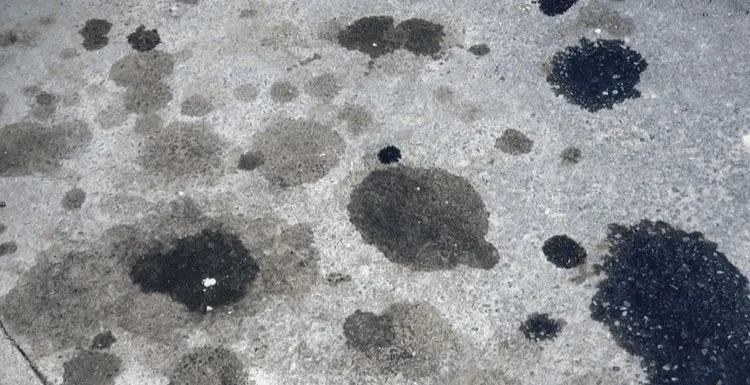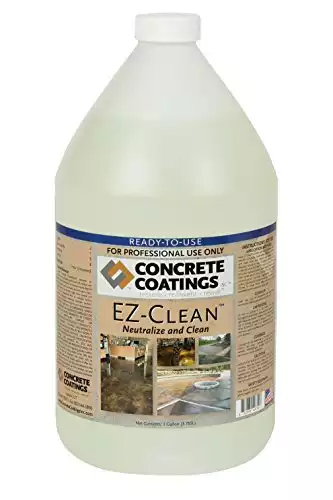All it takes is a moment’s inattention when changing the motor oil in a vehicle or small engine.
Before you know it, a pool of oil is spreading across the concrete floor of your garage or driveway.
How to Remove Oil Stains From Concrete
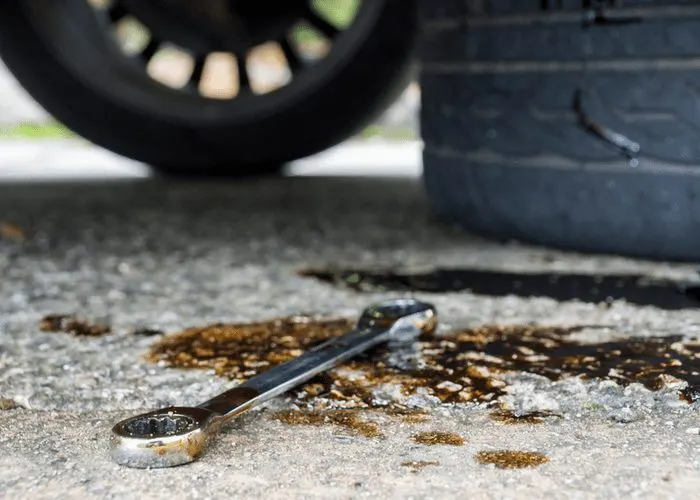
Jessica Dale/Shutterstock
A failed seal in a lawnmower, an unsuspected leak in an oil container, and other causes can add up to the same thing: a dark, greasy, hard-to-remove stain that can get tracked elsewhere on the concrete and even into your house.
Oil stains on concrete can be tough to remove. Concrete is porous, so liquids, including oil, can seep into the surface, where they resist many cleaning methods.
However, if you know what to do, you can remove oil from concrete and restore the surface to its original condition.
The International Concrete Repair Institute suggests these methods for cleaning oil from garages, driveways, sidewalks, and other concrete surfaces.
Removing Fresh Oil Spills
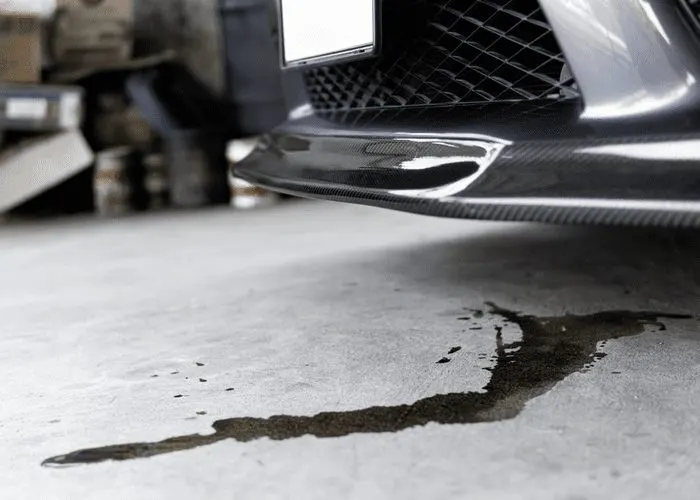
Nongasimo/Shutterstock
The best thing to do with an oil spill is to clean it up immediately. Start by removing the surface oil.
You can use several absorbent materials to soak up the spill. Paper or cloth towels work. But be sure to blot instead of wiping.
Wiping tends to spread the stain and push the greasy liquid deeper into the concrete. After blotting up as much as possible, cover the stain with powdered absorbent material.
Kitty litter is often used for this purpose. Some cleaning experts advise avoiding the more expensive brands of kitty litter. All kitty litter is made of absorbent clay.
But the costlier varieties also include clumping additives that cause the litter to clump up when it encounters moisture. You can also use other absorbents.
Dry Portland cement, talcum powder, diatomaceous earth, Fuller’s earth, and even cornmeal or corn starch all work well. Leave the absorbent on the spot for 24 hours.
Remove and repeat until the absorbent material doesn’t absorb any more oil. With luck, that may do it. Otherwise, proceed to the next step.
Removing Old or Stubborn Stains
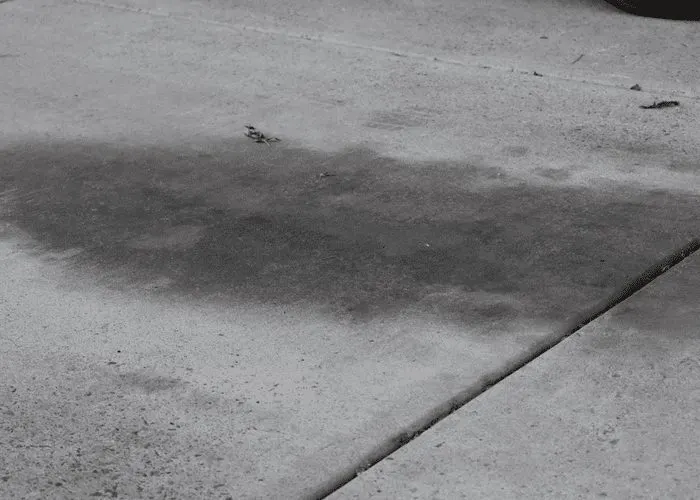
DMFhotography/Shutterstock
If quick attention to the spot doesn’t fix it, or if you’re dealing with a dried-on stain, you can get out the remaining oily residue using cleaning agents.
Soap, scouring powder, trisodium phosphate, and special cleaners designed for getting oil out of concrete can all do the job. There are a few different methods you can try.
Note that all these methods use more or less powerful chemical cleaning agents. Make sure the space you are cleaning is well-ventilated.
Use eye protection, gloves, long sleeves, and pants when cleaning with these techniques. Avoid getting cleaners on your bare skin, and rinse with plenty of water if you do get splashed.
1. Remove Oil From Concrete With Trisodium Phosphate
The first approach is the poultice method using trisodium phosphate, a powerful cleaner available at home improvement stores. Mix 1 part trisodium phosphate with 6 parts water.
Spread the resulting paste over the stain in a layer that is approximately one-half inch thick. If children or pets might get into the area, cover the poultice with a layer of plastic sheeting.
Let the poultice dry for a day. Scrape off the dried mixture. Now scrub the surface while rinsing with water.
2. Remove Oil From Concrete With Sodium Hydroxide
A second approach is to use caustic soda, also called lye or sodium hydroxide, another harsh dirt remover used in drain cleaners and oven cleaners. You can buy caustic soda online or at many home improvement centers.
Make a poultice using a solution of 5 percent sodium hydroxide. Spread it, covering it if necessary for safety. Let it dry for 24 hours. Remove and scrub with water.
3. Remove Oil From Concrete With Paint Thinner
A third method is to use mineral spirits, also called paint thinners, made from petroleum. Apply the mineral spirits directly to the stain. Wait just one hour.
By this time, the solvent should have evaporated. You may need to repeat this process. Scrub with water to finish.
4. Remove Oil From Concrete With Acetone
A fourth method uses a cloth bandage dipped in a mixture of equal parts of acetone, which is also used for nail polish remover, and amyl acetate.
Amyl acetate is available online and from chemical supply houses. Apply the bandage so it extends past the area of the stain. Now cover the area with a dry, heated slab of concrete, stone, or a glass pane.
The heat will help pull some of the oil from the concrete pores. It does this by soaking into the bandage and causing the rest to sink deeper, so it doesn’t show on the surface. When the bandage is removed, the stain should be gone.
5. Remove Oil From Concrete With Trichlorethylene
Finally, a fifth approach calls for soaking a bandage with trichloroethylene, an industrial solvent sold online and mostly used to clean grease from metal parts. This chemical is also found in glue, paint remover, and spot removers.
This method also uses a heated slab or pane to stimulate the cleaning process. Follow the same procedure as with acetone and amyl acetate.
Other Methods
A big stain that has been on the concrete for a long time may call for a different approach.
You may encounter this problem if you clean a driveway or parking area where a vehicle with a leaky oil gasket has been parked for an extended period of time.
In this case, the concrete repair institute suggests using mineral spirits, also called paint thinner. After saturating the stained area with the solvent, cover it with an absorbent material such as kitty litter.
After letting it stand overnight, sweep up the absorbent material and examine the stain. Repeat as necessary until the stain is gone. Scrubbing with trisodium phosphate can also work for dried-on oil stains.
Rather than relying only on elbow grease, consider mixing the trisodium phosphate with kitty litter or diatomaceous earth and applying it to the stain.
Let it sit overnight to dissolve and soak up the oil, then rinse with water. As a final step to remove any discoloration, you can bleach the concrete surface. Use ordinary laundry bleach and rinse thoroughly.
Commercial Oil Removers
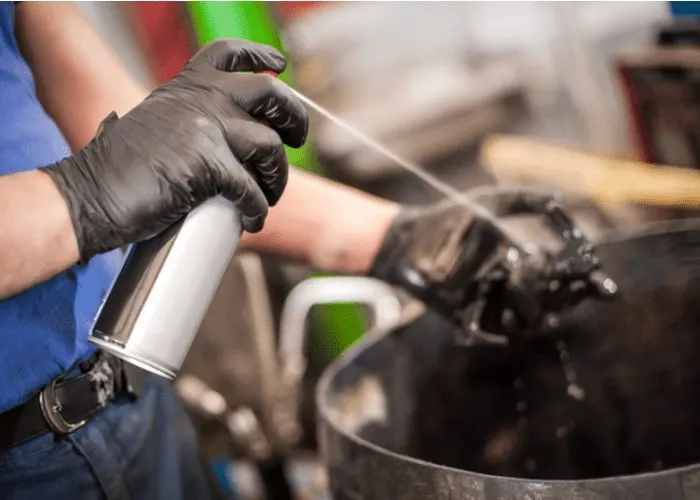
GuruXOX/Shutterstock
These do-it-yourself techniques, some of them using materials you already have around the house, can do an excellent job of removing oil stains from concrete.
For a more packaged solution that may cost a little more, consider some of the commercial oil-removing cleaners available on the market.
Some of these are available in powdered form and are mixed with water and applied to the concrete. Others may already be in liquid form.
You can get commercial cleaners like these at home improvement centers, auto supply stores, and general retailers. Prosoco’s Stand Off is one of the more frequently recommended commercial oil removers.
Stand Off is a poultice-style cleaner that requires no mixing or soaking of cloth bandages. The ready-to-use liquid already contains a blend of powdered absorbents.
You just pour it on. Spread it with a broom. Wait five to eight hours. Then sweep up the dried residue. No scrubbing is required.
The product can also be used on brake fluid, power steering fluid, hydraulic fluid, anti-freeze, and grease from cooking oils.
The manufacturer says it works on poured concrete, pavers, concrete blocks, and tile. It is safe for marble, granite, limestone, and travertine floors but is not recommended for asphalt surfaces.
Other commercial oil cleaners include Oil Eater and Chomp! Pull it out. Alternatively, Oillift is a certified, non-toxic, eco-friendly oil stain remover.
So, How Do You Remove Oil Stains From Concrete?
Cleaning oil stains from concrete can be a frustrating job with unsatisfactory results if you approach it like any other mess.
However, using these tried-and-true approaches, you can remove unsightly oil stains and get your garage, driveway, sidewalk, or other concrete surface looking new again.

